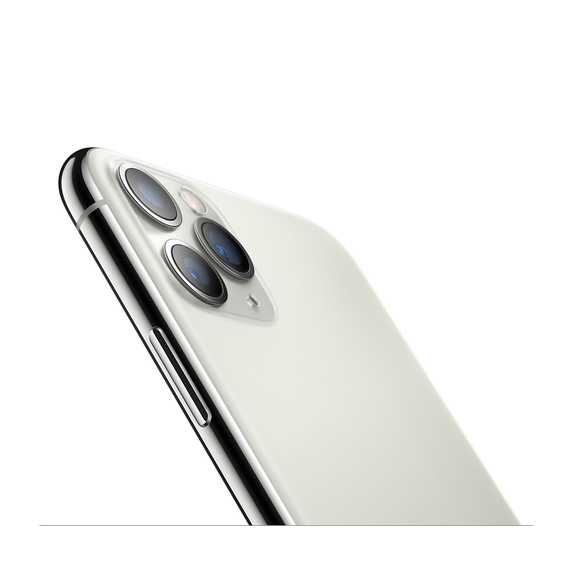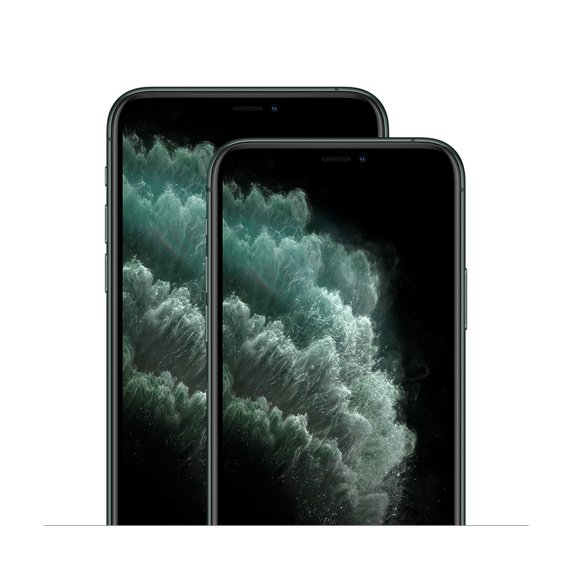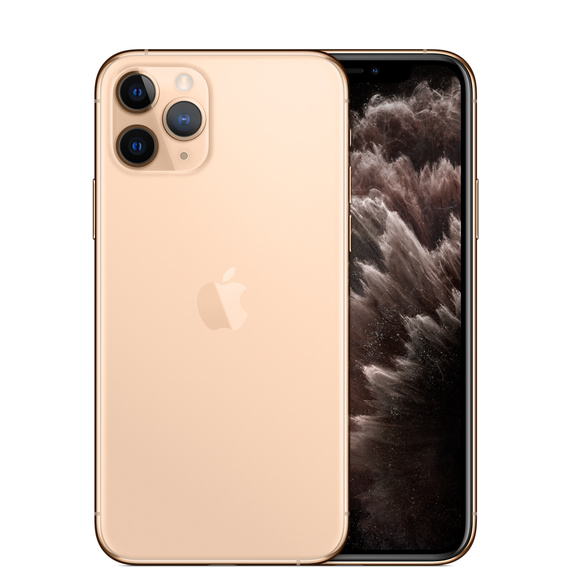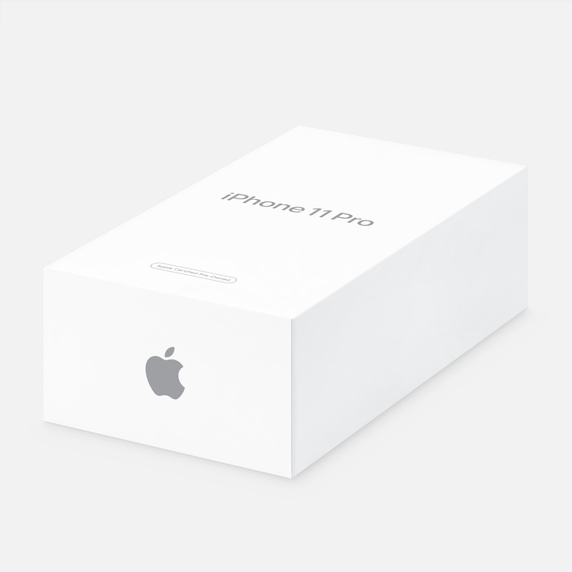The iPhone 11 Pro, which goes on sale alongside the less expensive and less feature-rich iPhone 11 on September 10, 2019, is Apple’s newest flagship model.
The 5.8-inch and 6.5-inch iPhone 11 Pro and iPhone 11 Pro Max, according to Apple, have a new “Pro” name since they are made for people who desire the greatest smartphone currently on the market.
Both of the new iPhones have Super Retina XDR OLED screens, with the 6.5-inch iPhone giving a resolution of 2688 x 1242 and the 5.8-inch iPhone 11 Pro offering a resolution of 2426 x 1125.
The latest smartphones include HDR capability, a contrast ratio of 2,000,000:1, and a maximum brightness of 800 nits (1200 for HDR). Wide colour for more vibrant, true-to-life colours is also included, along with True Tone to adjust the display’s white balance to the room’s ambient illumination to make it easier on the eyes.
The iPhone 11 Pro don’t have 3D Touch; instead, Apple gave the new models a feature called Haptic Touch that is comparable. Although it is available throughout iOS 13, haptic touch does not have the pressure sensitivity of 3D touch.
The 2019 iPhones don’t appear all that different, but according to Apple, they have the strongest glass ever used in a smartphone and better water resistance (IP68), which increases their overall endurance.
Dolby Atmos is available, and spatial audio support provides a more immersive audio experience.
The triple-lens camera arrangement on the iPhone 11 Pro is what sets it out most from earlier iPhone models. Triple 12-megapixel ultra wide angle, wide angle, and telephoto cameras are available on Apple’s newest iPhone models.
With a 120-degree field of view, the new ultra-wide camera enables superior landscape and close-up photographs that can catch more without repositioning the iPhone.
In comparison to the iPhone XS, the telephoto lens’s bigger f/2.0 aperture enables it to collect 40% more light.
The iPhones offer 2x optical zoom in, 2x optical zoom out, and digital zoom up to 10x thanks to the addition of an ultra-wide-angle camera.
The wide-angle and telephoto lenses both feature dual optical image stabilization capabilities, the True Tone flash is stronger, and the cameras include next-generation smart HDR, which can automatically identify things in the frame and relight them for more detailed, realistic-looking images.
The ultra wide-angle camera on the iPhone 11 Pro has been upgraded to provide a more immersive experience that allows you to view and photograph the region outside of the frame if desired.
Similar to the Night Sight feature on Google Pixel smartphones, Apple has included a new Night Mode that makes advantage of the iPhone’s processing power to take bright, sharp, and clear images even in extremely low lighting circumstances.
Wide and telephoto framing options are available while using Portrait Mode, giving Portrait mode a larger field of vision for photos of portraits of many individuals.
In iOS 13.2, a new Deep Fusion tool that optimizes for texture, details, and noise processes photographs pixel-by-pixel using cutting-edge machine learning algorithms.
All cameras can capture video in 4K with the increased dynamic range at 24, 30, or 60 frames per second, and live camera changing is possible.
Holding down the shutter button when in QuickTake video mode triggers an automated recording of video with subject tracking, and the Audio Zoom function syncs the audio to the video frame for more dynamic audio.
Read Also: iPhone 8 Plus Price in Nigeria: How much is iPhone 8 Plus in Nigeria (UK Used, Slot, Jumia)
iPhone 11 Pro Price in Nigeria
The iPhone price in Nigeria in Nigeria starts at NGN358,000 Naira to NGN490,000 Naira depending on the model and the vendor you’re buying from.
iPhone 11 Pro Price in Konga, Nigeria
The iPhone price in Nigeria on Konga starts at NGN380,99 Naira to NGN480,00 Naira depending on the model and the vendor you’re buying from.
iPhone 11 Pro Price in Jumia, Nigeria
The iPhone price in Nigeria on Jumia starts at NGN400,000 Naira to NGN548,000 Naira depending on the model and the vendor you’re buying from.
iPhone 11 Pro Price in Slot, Nigeria
The iPhone price in Nigeria on Jumia starts at NGN380,000 Naira to NGN500,000 Naira depending on the model and the vendor you’re buying from.
iPhone 11 Pro Design

The iPhone 11 Pro and 11 Pro Max have the same aesthetic as the iPhone XS and XS Max. They have full-screen OLED displays that span from edge to edge and top to bottom with thin bezels, measuring 5.8 and 6.5 inches, respectively.
The TrueDepth camera system, front speakers, and other sensors are housed in a notch on the front of the iPhone 11 Pro and 11 Pro Max, but other than those elements and a thin bezel that surrounds each device’s sides, everything else on the phones is a display.
The two smartphones use Face ID for biometric authentication rather than the Home button, bottom bezel, or Touch ID fingerprint sensor.
The regular mute switch and volume controls are located on the left side of the iPhone 11 Pro and Pro Max, while the side button that serves as the power button is located on the right side.
The iPhone 11 Pro and Pro Max seem identical to the iPhone XS and XS Max from the front, but Apple made some significant alterations to the device’s rear.
The camera is now a giant square-shaped bump with three triangle-shaped lenses, a flash, and a microphone close by.
To accommodate the new triple-lens camera system, the iPhone 11 Pro and the 11 Pro Max are both a little bit thicker and heavier than their predecessors.
The dimensions of the iPhone 11 Pro are 144mm high, 71.4mm broad, and 8.1mm thick. It is 188 grams heavy. Comparatively, the iPhone XS was 177 grams, 143.6mm tall, 70.9mm broad, and 7.7mm thick.
Finish and colours
The iPhone XS and XS Max featured a glossy surface, but Apple used a matte texture that seems more like brushed glass for the iPhone 11 and 11 Pro.
This year, there are four colours: Midnight Green, Space Gray, Silver, and gold. The deep, forest green tint known as Midnight Green, which Apple has never before employed, was made feasible by ink processes developed by Seiko Advance, an Apple supplier.
Camera

The 12-megapixel rear camera system on the iPhone 11 has two lenses. It features two lenses: one /1.8 wide-angle lens and one /2.4 ultra-wide-angle lens with a 120° field of view and a 2 optical zoom out.
The iPhone 11 can play 4K video at up to 60 frames per second and 1080p slow motion at up to 240 frames per second. Similar to the Pro model, the phone also has an audio zoom feature that concentrates sounds on the region being zoomed in.
Although only the primary lens features OIS, both cameras are capable of recording video. With six portrait lighting settings, depth adjustment, and a sophisticated bokeh effect, it enables portrait mode.
The phone also boasts an automated night mode that enables the camera to capture images in low light with less noise and more brightness.
Additionally, a newly updated camera software has new features like a scroll wheel for selecting the various lenses and “QuickTake,” which enables users to long-press the shutter button to record a video.
On October 29, 2019, the iOS 13.2 software update included Apple’s new Deep Fusion feature, which uses AI and machine learning for picture processing.
Using Dolby Atmos and spatial audio
For a more realistic audio experience, the iPhone 11 Pro has a new spatial audio capability that simulates surround sound. It also accommodates Dolby Atmos audio.
Resistance to dust and water
The iPhone 11 Pro features an IP68 water resistance rating, which makes it more water resistant than the iPhone XS from earlier in the generation.
In comparison to the two-meter rating in the XS and the two-meter rating in the current iPhone 11, it is rated to survive a depth of four meters (13 feet) for up to 30 minutes.
The iPhone 11 Pro can withstand dirt, dust, and other particles thanks to its IP68 rating of 6 for dust resistance and 8 for water resistance. The highest level of dust resistance is IP6x.
The iPhone 11 Pro can endure splashes, rain, and brief accidental water exposure thanks to its IP68 water resistance classification, although it should be avoided if at all possible. Apple cautions that water and dust protection are not always present and degrade due to everyday use.
Because liquid damage to iOS devices is not covered by Apple’s guarantee, it is essential to exercise caution while submerging the iPhone 11 Pro in liquids.
Durability
The iPhone 11 Pro is constructed with the toughest glass ever used in a smartphone, so it ought to be more resistant to unforeseen bumps, drops, scratches, and other little harm. But because it’s still glass, it’s advisable to have a case or AppleCare+ in case of a mishap.
The front and back glass were strengthened using a “dual ion-exchange technique,” according to Apple, making it more durable than earlier generations.
Display

The iPhone 11 Pro and iPhone 11 Pro Max use a “Super Retina” XDR display, which Apple says is its best display ever in an iPhone. The Super Retina display features support for Dolby Vision, HDR10, and a wide colour gamut for unparalleled colour accuracy.
The Super Retina display features vivid, true-to-life colours, deeper blacks, and, new this year, a 2,000,000:1 contrast ratio, up from 1,000,000:1.
The iPhone 11 Pro’s display is considerably better than a conventional LCD display, like the one in the iPhone 11, especially in terms of highlights and shadows.
Everything seems more realistic than it does in real life because blacks are blacker and whites are whiter.
The iPhone 11 Pro versions now have enhanced maximum brightness, with 1200 nits for HDR and 800 nits for regular use (up from 625 nits).
True Tone support is included, enabling the iPhone’s ambient light sensor to modify the display’s white balance to match the lighting in a room, reducing eyestrain for a more similar reading experience to that of paper.
While the 6.5-inch iPhone 11 Pro Max has a resolution of 2688 x 1242 at 458 PPI, the 5.8-inch iPhone 11 Pro has a resolution of 2436 x 1125 at 458 PPI.
The substantial battery life improvements in the iPhone 11 Pro versions are made possible by Apple’s newest display, which is 15% more power-efficient.
DisplayMate, a testing and calibration company, has awarded the iPhone 11 Pro Max its best display grade ever.
According to DisplayMate, the iPhone 11 Pro Max “significantly improves display performance above other competitive smartphones.”
Bionic Processor A13
The iPhone 11 Pro and Pro Max are powered by the improved, new A13 Bionic processor. According to Apple, the A13 Bionic processor is the fastest chip ever utilized in a smartphone.
It is quicker and more effective than the A12 Bionic chip found in the previous-generation iPhones.
In comparison to the A12, the A13’s CPU’s two performance cores are up to 20% faster and consume 30% less power, while its four efficiency cores are up to 20% quicker and consume up to 40% less power.
The GPU in the A13 uses 40% less power and is 20% quicker than the GPU in the A12.
AnandTech’s research indicates that the A13 in the iPhone 11 and 11 Pro provides 20 per cent quicker CPU performance and sustained graphics performance that is 50 to 60 per cent greater than that of the iPhone XS.
Brain Engine
The next-generation 8-core Neural Engine in the A13 processor, according to Apple, is quicker than ever for real-time image and video analysis.
The CPU can operate up to six times faster with two Machine Learning Accelerators, producing more than 1 trillion operations per second.
The Neural Engine is up to 20% quicker and consumes up to 15% less power than the Neural Engine from the previous iteration. Apple claims that the Face ID, AR applications, and other features are all powered by its Neural Engine.
The A13 Bionic’s power can be utilized by applications and games thanks to Core ML 3, which is available for developers.
Haptic Touch
The 2019 iPhone range does not have the Haptic Touch 3D Touch technology, which has been absent from iPhones since the iPhone 6s.
The iPhone XR was the first device to incorporate the new Haptic Touch function, which is now included on the iPhone 11, iPhone 11 Pro, and iPhone 11 Pro Max.
Similar in functionality to 3D Touch, haptic Touch does not require pressure to operate, therefore there are just one or two options available for each push. In contrast, haptic feedback through haptic touch is similar to a lengthy push.
With the exception of the pressure-based feedback, most users are not losing functionality when switching to Haptic Touch because it can be utilized in many of the same areas that supported 3D Touch.
Please read our Haptic Touch guide for additional information on how it differs from the old 3D Touch.
Performance

“Our iPhone 11 Pro scored 1361 on the single-core GeekBench 5 test after three runs. The multi-core run also gave us a 3561 average across three runs.
For comparison, the Galaxy Note 10 Plus that we reviewed earlier in September scored 741 on the single-core test and 2701 on the multi-core test using the updated suite. “While Metal is used on the Mac and iOS, the GeekBench 5 Compute score was significantly higher and uses Vulkan everywhere else.
The iPhone 11 Pro earned 6309, while the Galaxy Note 10 received a score of 221.
The RAM, CPU, GPU, UX, and UX tests generated a cumulative score of 456760 on the AnTuTu benchmark, which we also performed.
That compares nicely with the performance of our iPhone XS, which earned a total score of 370618. The CPU and GPU areas saw the biggest increases. \s ” However, the iPhone 11 Pro is really speedy, as you can see. How much of this is genuinely relevant in the modern world?
As you would think, the AppleInsider crew has a huge collection of iPhones that spans a decade.
Most of them can still be used as phones, although after around four years, their usefulness with more modern apps is questioned “It operates in this manner.
The older iPhones are being subjected to more demands from Apple, developers, and users, not less.
“They are preparing customers to use the iPhone for two years as they prepare them to use the fastest mobile CPU, as they have done for the previous seven years in a row. the best in class or very near to the top model.
Additionally, it’s not unusual to use an iPhone for four years or more. In this sense, Apple is a victim of its own success.” The majority of Android phones are suitable for the year they were released.
Most people can hardly move fast enough to avoid being impeded by the OS, and the flagships are adequate for the present and perhaps the next 30 months, provided you can buy a current version of Android for it.
True Depth and Face ID Camera
The iPhone 11 Pro and Pro Max support Facial ID, Apple’s face recognition biometric authentication system that has been in use since 2017. Face ID components are housed in the True Depth camera system located in the notch on the front of the iPhone.
Apple’s new hardware in the iPhone 11 Pro and Pro Max improves the TrueDepth camera system. It is 30% faster than before in authenticating passwords and transactions and unlocking the smartphone, in addition to being made to work from a wider range of angles.
Face ID is used across iOS for a variety of tasks, including unlocking your iPhone, providing access to third-party passcode-protected applications, confirming purchases in iTunes and the App Store, and authenticating Apple Pay transactions.
Face ID uses a number of the sensors and cameras that are part of the TrueDepth camera system in the iPhone 11 Pro Max. A 3D facial scan that records the contours and planes of each unique face is created using an infrared camera that scans more than 30,000 invisible infrared dots that are projected by a dot projector onto the skin’s surface.
Because of the Neural Engine built into the A13 Bionic chip, Face ID can adapt to small changes in a user’s appearance over time. As a result, even if your hair grows out or you start to grow a beard, Face ID can still unlock your iPhone.
Battery’s life
The iPhone 11 Pro and Pro Max now have an impressively improved battery life thanks to the A13 Bionic chip, upgrades to the Super Retina XDR display, and a new power management system built by Apple.
In fact, according to Apple, it is the biggest improvement in iPhone battery life yet.
When compared to the iPhone XS, the battery in the iPhone 11 Pro can last up to four hours long, and when compared to the iPhone XS Max, the battery in the iPhone 11 Pro Max can last up to five hours long.
The iPhone 11 Pro has a real-world battery life of up to 18 hours for viewing videos, 11 hours for streaming videos, and 65 hours for playing music.
When watching videos, streaming movies, and playing music, the iPhone 11 Pro Max can last up to 20 hours, 12 hours, and 80 hours, respectively.
Compared to the XS and XS Max, the iPhone 11 Pro and Pro Max batteries are bigger and heavier. In comparison to the iPhone XS, which has a 2,658 mAh battery, the iPhone 11 Pro has a 3,046 mAh battery.
Compared to the 3,174 mAh battery in the iPhone 11 Pro, the iPhone 11 Pro Max has a 3,969 mAh battery.
In tests, an iPhone XS Max consumed less power when in Dark Mode than when in Light Mode, suggesting that iOS 13’s Dark Mode may offer some battery-saving features in OLED iPhones.
The iPhone 11 models include a new hybrid software and hardware system for performance management, which is more advanced than the battery and power management systems on prior iPhones, according to an Apple support document.
According to Apple, the function aims to deliver “optimal performance as battery ageing happens over time.” The new iPhones’ power requirements are continually tracked, and performance is regulated in real-time.
Connectivity
LTE Gigabit-Class
Because the iPhone 11 Pro and 11 Pro Max support gigabit-class LTE with 4×4 MIMO and LAA, LTE is quicker than before.
Different LTE technologies, such as 4×4 MIMO and LAA, increase LTE speeds as quickly as feasible by combining licensed and unlicensed airwaves, multiple data streams, and multiple antennas.
The most cutting-edge LTE technology in an iPhone is found in the iPhone 11 Pro and 11 Pro Max, while the less expensive iPhone 11 has Gigabit LTE but only supports 2×2 MIMO.
The two new iPhones have better maximum LTE speeds, but they don’t support 5G, thus they won’t function on 5G networks. Both the Pro and Pro Max models of the iPhone 11 come with Intel modems.
The latest iPhones support up to 30 LTE bands, which is helpful while travelling. With broader LTE band compatibility, your iPhone is more likely to function with local LTE networks when you travel as various nations utilize different LTE bands.
Support for Dual-SIM
The iPhone 11 Pro and Pro Max both enable dual SIM, enabling simultaneous usage of two phone numbers. One physical nano-SIM slot and an eSIM are required for dual-SIM capability.
The eSIM capability is accessible in many nations throughout the world, and Apple’s website has a complete list of carriers that accept eSIM.
In Austria, Canada, Croatia, the Czech Republic, Germany, Hungary, India, Spain, the UK, and the United States, dual SIMs are compatible with a few carriers.
Wideband Ultra
The iPhone 11 Pro variants come with a brand-new U1 processor from Apple, which supports Ultra Wideband technology for enhanced spatial awareness.
The technology makes it possible for the iPhone 11 to accurately locate other U1-enabled Apple devices, which will ultimately make it simpler to find a misplaced handset.
Since Ultra Wideband was created expressly for better indoor location, Apple has compared it to “GPS at the scale of the living room.” This comparison is correct.
AirDrop is one instance of how Apple makes use of the U1 processor. According to Apple, you only need to aim your iPhone towards another iPhone for it to appear top of your list of AirDrop targets. iOS 13.1 is expected to introduce this capability.
WiFi and Bluetooth
Bluetooth 5.0 is supported on the iPhone 11 Pro. Longer range, quicker speeds, more broadcast message capacity, and improved compatibility with other wireless technologies are all features of Bluetooth 5.0.
Bluetooth 5 provides four times the range, twice the speed, and eight times the capacity for broadcast messages as compared to Bluetooth 4.2.
802.11ax WiFi, or WiFi 6 with 2×2 MIMO, is supported. The newest WiFi protocol, WiFi 6, allows for up to a 38% faster download speed than WiFi 5. (aka 802.11ac).
Although WiFi 6 is a new WiFi protocol and is not yet extensively adopted, its support will become more and more crucial over the next years.
NFC and GPS
The iPhone 11 Pro and Pro Max contain GPS, GLONASS, Galileo, and QZSS support for location services.
The iPhone models support NFC with reader mode and include a background tag function that enables NFC tag scanning without opening an app first.

